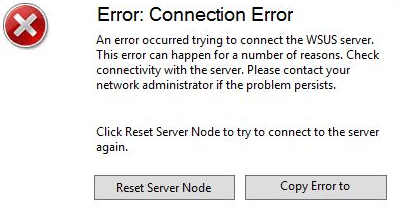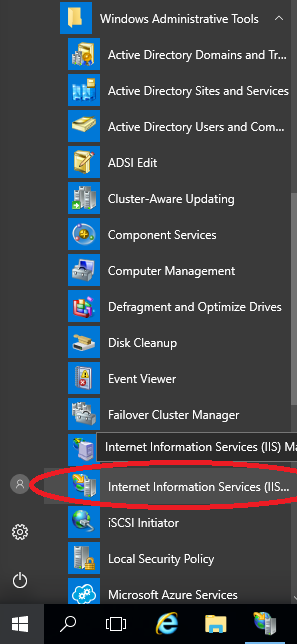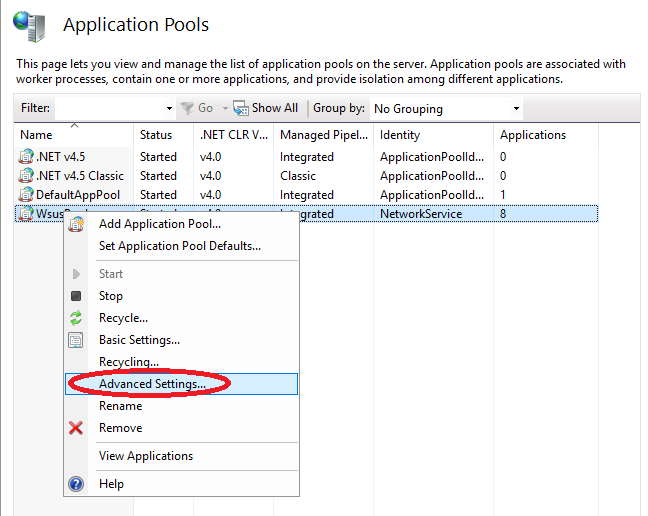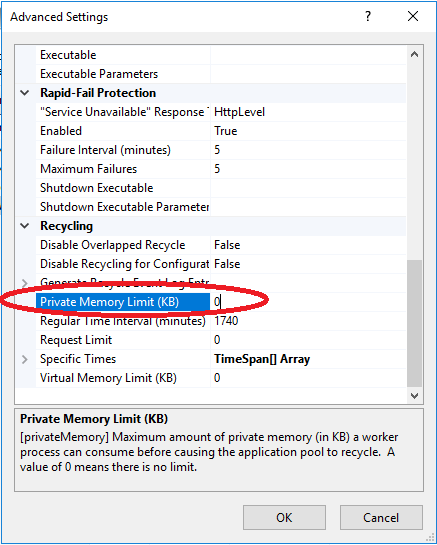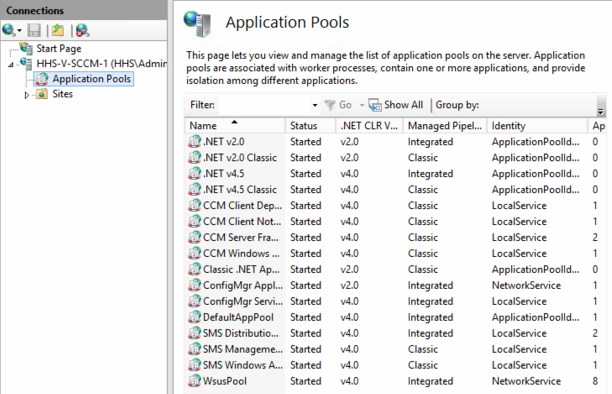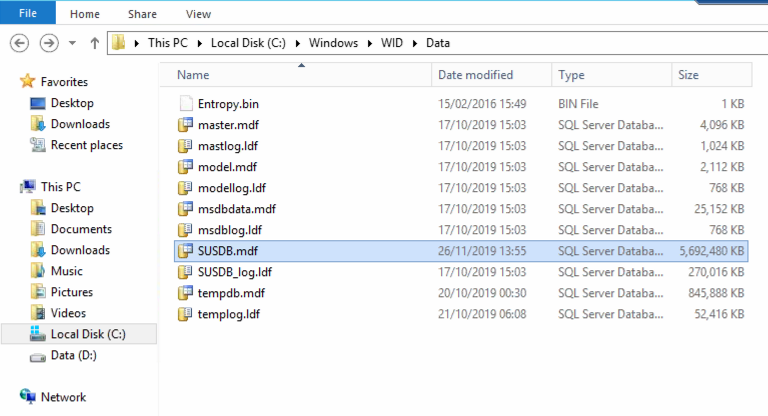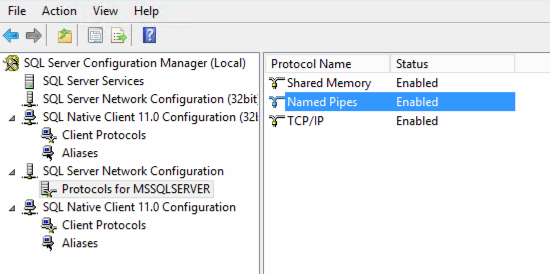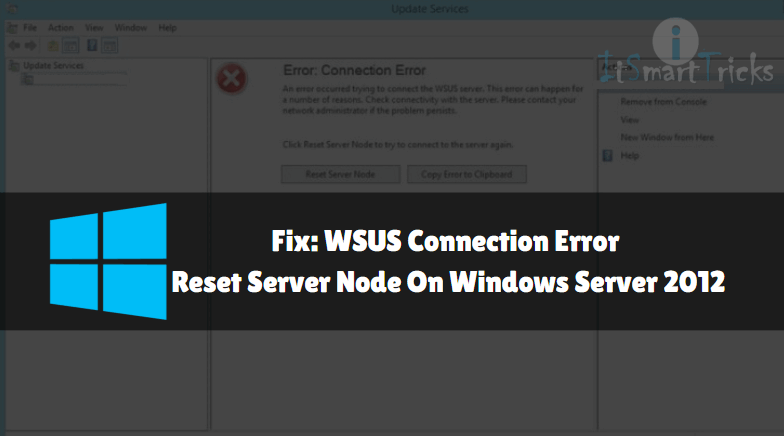- Remove From My Forums
-
Question
-
I keep getting this Error:Connection Error message and even if I restart IIS and the WSUS service the reset node button doesn’t work. I have to do a full reboot.
Here is the error I get
The WSUS administration console was unable to connect to the WSUS Server via the remote API.
Verify that the Update Services service, IIS and SQL are running on the server. If the problem persists, try restarting IIS, SQL, and the Update Services Service.
The WSUS administration console has encountered an unexpected error. This may be a transient error; try restarting the administration console. If this error persists,
Try removing the persisted preferences for the console by deleting the wsus file under %appdata%MicrosoftMMC.
System.IO.IOException — The handshake failed due to an unexpected packet format.
Source
SystemStack Trace:
at System.Net.Security.SslState.StartReadFrame(Byte[] buffer, Int32 readBytes, AsyncProtocolRequest asyncRequest)
at System.Net.Security.SslState.StartReceiveBlob(Byte[] buffer, AsyncProtocolRequest asyncRequest)
at System.Net.Security.SslState.CheckCompletionBeforeNextReceive(ProtocolToken message, AsyncProtocolRequest asyncRequest)
at System.Net.Security.SslState.ForceAuthentication(Boolean receiveFirst, Byte[] buffer, AsyncProtocolRequest asyncRequest)
at System.Net.Security.SslState.ProcessAuthentication(LazyAsyncResult lazyResult)
at System.Threading.ExecutionContext.RunInternal(ExecutionContext executionContext, ContextCallback callback, Object state, Boolean preserveSyncCtx)
at System.Threading.ExecutionContext.Run(ExecutionContext executionContext, ContextCallback callback, Object state, Boolean preserveSyncCtx)
at System.Threading.ExecutionContext.Run(ExecutionContext executionContext, ContextCallback callback, Object state)
at System.Net.TlsStream.ProcessAuthentication(LazyAsyncResult result)
at System.Net.TlsStream.Write(Byte[] buffer, Int32 offset, Int32 size)
at System.Net.ConnectStream.WriteHeaders(Boolean async)
** this exception was nested inside of the following exception **System.Net.WebException — The underlying connection was closed: An unexpected error occurred on a send.
Source
Microsoft.UpdateServices.AdministrationStack Trace:
at Microsoft.UpdateServices.Administration.AdminProxy.CreateUpdateServer(Object[] args)
at Microsoft.UpdateServices.UI.SnapIn.Scope.ServerSummaryScopeNode.GetUpdateServer(PersistedServerSettings settings)
at Microsoft.UpdateServices.UI.SnapIn.Scope.ServerSummaryScopeNode.ConnectToServer()
at Microsoft.UpdateServices.UI.SnapIn.Scope.ServerSummaryScopeNode.get_ServerTools()What do I need to do to fix this? I’ve looked around online and haven’t found a solution that seems to work.
Thank you
Hi, I have installed a new VM 2 days ago.
Server 2016 Standard (with GUI), 4 CPU cores 12GB RAM 500GB HDD.
Installed the WSUS role with all prerequisites and synchronized.
I open the WSUS console locally from Server Manager, It takes about a minute for the first page to load the data, than when i try to see the list of updates that needs to be approved it hangs at 0% Loading for about 2-3 minutes and then gives me this:
And:
The WSUS administration console was unable to connect to the
WSUS Server via the remote API.
Verify that the Update Services service, IIS and SQL are
running on the server. If the problem persists, try restarting IIS, SQL, and
the Update Services Service.
System.Net.WebException — The operation has timed out
Source
System.Web.Services
Stack Trace:
at
System.Web.Services.Protocols.WebClientProtocol.GetWebResponse(WebRequest
request)
at
Microsoft.UpdateServices.Internal.DatabaseAccess.ApiRemotingCompressionProxy.GetWebResponse(WebRequest
webRequest)
at
System.Web.Services.Protocols.SoapHttpClientProtocol.Invoke(String methodName,
Object[] parameters)
at
Microsoft.UpdateServices.Internal.ApiRemoting.ExecuteSPSearchUpdates(String
updateScopeXml, String preferredCulture, Int32 publicationState)
at
Microsoft.UpdateServices.Internal.DatabaseAccess.AdminDataAccessProxy.ExecuteSPSearchUpdates(String
updateScopeXml, String preferredCulture, ExtendedPublicationState
publicationState)
at
Microsoft.UpdateServices.Internal.BaseApi.Update.SearchUpdates(UpdateScope
searchScope, ExtendedPublicationState publicationState, UpdateServer
updateServer)
at
Microsoft.UpdateServices.UI.AdminApiAccess.UpdateManager.GetUpdates(ExtendedUpdateScope
filter)
at
Microsoft.UpdateServices.UI.AdminApiAccess.WsusSynchronizationInfo.InitializeDerivedProperties()
at
Microsoft.UpdateServices.UI.SnapIn.Pages.SyncResultsListPage.GetSyncInfoRow(WsusSynchronizationInfo
syncInfo)
at Microsoft.UpdateServices.UI.SnapIn.Pages.SyncResultsListPage.GetListRows()
I have no problem installing a new VM from scratch as this is a new server and I haven’t made any change to the GPO yet.
I would really appreciate any help!
Thank you,
Ofir Gavish.
On a fresh or existing WSUS install, you may notice that the WSUS Administrator MMC applet stops functioning and present the error “Error: Connection Error – An error occurred trying to connect to the WSUS Server.”
I originally experienced this on Windows Server Update Services running on Windows Server 2012 R2 and applied the fix. Recently, I deployed Windows Server Update Services on a new Windows Server 2019 – Server Core install, and experienced this issue during the first synchronization. Before realizing what the issue was, I attempted to re-install WSUS and IIS from scratch numerous times until I came across old notes. One would have thought they would have resolved this issue on a new server operating system.
When the issue occurs, all processes will appear to be running on the server. Looking at the server event log, you’ll notice multiple application errors:
-
Event ID: 13042 - Windows Server Update Services Description: Self-update is not working.
-
Event ID: 12002 - Windows Server Update Services Description: The Reporting Web Service is not working.
-
Event ID: 12012 - Windows Server Update Services Description: The API Remoting Web Service is not working.
-
Event ID: 12032 - Windows Server Update Services Description: The Server Synchronization Web Service is not working.
-
Event ID: 12022 - Windows Server Update Services Description: The Client Web Service is not working.
-
Event ID: 12042 - Windows Server Update Services Description: The SimpleAuth Web Service is not working.
-
Event ID: 12052 - Windows Server Update Services Description: The DSS Authentication Web Service is not working.
-
Event ID: 12072 - Windows Server Update Services Description: The WSUS content directory is not accessible. System.Net.WebException: The remote server returned an error: (503) Server Unavailable. at System.Net.HttpWebRequest.GetResponse() at Microsoft.UpdateServices.Internal.HealthMonitoring.HmtWebServices.CheckContentDirWebAccess(EventLoggingType type, HealthEventLogger logger)
You will also see the below error message when attempting to use the WSUS MMC.
The Problem
This issue occurs because the WSUS application pool in IIS “WsusPool” has reached it’s maximum private memory limit and attempts to recycle the memory usage.
Ultimately I believe this causes the IIS worker process to crash since it has run out of memory, and the pending command (whether it’s a synchronization or something else) fails to complete.
Previously, I noticed database corruption on a WSUS SQL Express database when this issue occurred, so I recommend applying the fix on a fresh install of WSUS.
The Fix
To resolve this issue, we need to adjust the max
- On the server running WSUS and IIS, open the “Internet Information Services (IIS) Manager” inside of the “Windows Administrative Tools” (found in the start menu, or Control Panel).
- On the left hand side under “Connections”, expand the server, and select “Application Pools”.
- On the right hand side under “Application Pools” heading, right-click on “WsusPool” and select “Advanced Settings”.
- In the “Advanced Settings” window, scroll down until you see “Private Memory Limit (KB)”. Either change this to “0” (as shown below) to set no memory limit, or increase the limit to the value you prefer.
- Select “Ok” to close the window.
- Restart IIS by running “iisreset” from an administrative command prompt, restarting the server, or selecting “Restart” under “Manage Server” when looking at the default pane in IIS when the server is selected.
The issue should now be resolved and your WSUS server should no longer be crashing.
If you are applying this fix on a Server Core install, you’ll need to connect remotely to the IIS instance to apply the fix.
The Server Cleanup Wizard is a part of the WSUS UI that you can use to manage your disk space. This wizard can do tasks such as removing unused updates, deleting unused computers, deleting unneeded updates, and much more to clean up a WSUS partition. This guide covers how to resolve and prevent the “Connection Error” you see when you start the wizard.
Contents
- Extend the disk space using Disk Management
- Move the WSUS partition to another partition
- How can you prevent the connection error?
- Author
- Recent Posts
Tim Buntrock is one of three enterprise administrators for the Active Directory service of a «global player» in the contact center business. He is a certified engineer for MCTS, MCITP, MCSA and MCPS.
After you start the WSUS Cleanup Wizard, the following error message displays:
WSUS Connection Error
The error occurs because the partition doesn´t have enough disk space to write the log file that the Cleanup Wizard generates. If you can extend the disk space, you can run the wizard without this error.
Extend the disk space using Disk Management
- Open the Computer Management console by opening Run and typing msc.
- Click Disk Manager and right-click the volume that hosts the WSUS partition.
- Click Extend Volume.
- Follow the instructions on the server.
Move the WSUS partition to another partition
Open the command prompt and type the following commands:
Cd C:Program FilesUpdate ServicesTools wsusutil.exe movecontent W:WSUS W:WSUSMove.log
The last command will move the WSUS files to W: and create a log file with the name WSUSMove.log.
After a while, the content should be moved and your log file should look like this:
WSUS Move Log
If you can´t extend the disk space or move the content, you can remove WSUSContent files, run the Cleanup Wizard, and then fetch the WSUSContent with the database.
- Stop the Update service by running the following command:
net stop wuauserv
- Browse to the path WSUSDrive:WSUSWsusContent and remove enough updates for the wizard to be able to create a log file on the WSUS partition. In my case, the log file was about 2 GB.
- Start the Update service by running the following command:
net start wuauserv
- Open the WSUS administration console, select Options, and then select Server Cleanup Wizard. Select all check boxes and then click Next.
- When the cleanup has finished, run the following commands:
Cd C:Program FilesUpdate ServicesTools exe reset
The command wsusutil.exe reset tells WSUS to check each update in the database and verify that the content is present in the WSUSContent folder. If some updates aren´t located in the WSUSContent folder, WSUS will execute a BITS job to download the missing updates.
How do you know when the job is finished? You can verify this by checking the log file named SoftwareDistribution.log. It is located in C:Program FilesUpdate ServicesLogFiles.
If you open the log file using Notepad, you can search for Reset Agent Finished. You should find something like the following to indicate that the task has finished:
WsusService.14 ExecutionContext.runTryCode State Machine Reset Agent Finished
Software Distribution Log
How can you prevent the connection error?
You should extend the disk space of the WSUS partition as soon as possible. You should also create a scheduled task that cleans up your WSUSDrive. Here is how to do this:
- Save the following script to C:adminScriptsWSUSWSUSCleanup.ps1 on your server:
# WSUSCleanup.ps1 [reflection.assembly]::LoadWithPartialName("Microsoft.UpdateServices.Administration")` | out-null $wsus = [Microsoft.UpdateServices.Administration.AdminProxy]::GetUpdateServer(); $cleanupScope = new-object Microsoft.UpdateServices.Administration.CleanupScope; $cleanupScope.DeclineSupersededUpdates = $true $cleanupScope.DeclineExpiredUpdates = $true $cleanupScope.CleanupObsoleteUpdates = $true $cleanupScope.CompressUpdates = $true $cleanupScope.CleanupObsoleteComputers = $true $cleanupScope.CleanupUnneededContentFiles = $true $cleanupManager = $wsus.GetCleanupManager(); $cleanupManager.PerformCleanup($cleanupScope); # Script END
- Open the Task Scheduler on your server.
- Right-click Task Scheduler Library and select Create Basic Task.
- Define a Name and Description and click Next.
- Set the Trigger
- In the Action section, select Start a Program and enter the following options:
Program/script: powershell
Add arguments (optional): -file «C:adminScriptsWSUSWSUSCleanup.ps1»
- In the Finish section, select Open the Properties dialog for this task when I click Finish and then click Finish.
- To run whether user is logged on or not, select that option on the General Then, click OK and supply your credentials.
Problem
- A previously working WSUS console reports Error: Connection error, when you try and run the WSUS Cleanup wizard, or when you try and decline or delete obselete / superceeded updates
- The message is displayed around 3 minutes from when you started the operation
Example:
Products
- WSUS on Windows Server 2012 R2 with or without SCCM being installed on the same instance or Windows
Cause
- The WSUS database engine may run out of memory
- All WSUS operations must complete within a hard coded 3 minute timeout period
Resolutions
Try each resolution in order to resolve the issue.
- Initial Steps
- Resolution 1 — Wsus Application Pool Memory Limit
- Resolution 2 — Re-Index the Database
- Resolution 3 — Attempt to use Powershell to perform a WSUS Cleanup
- Resolution 4 — Manually cleanup the WID database using a SQL Script
Initial Steps
- Consider check-pointing the virtual machine so that you can roll-back changes, if required
- Try the following Powershell command from an Administrative command prompt:
Get-WsusServer | Invoke-WsusServerCleanup –CleanupObsoleteUpdates -CleanupUnneededContentFiles -CompressUpdates -DeclineExpiredUpdates -DeclineSupersededUpdates
Or:
Get-WsusServer | Invoke-WsusServerCleanup -CleanupUnneededContentFiles
Resolution 1
Remove the Wsus Application Pool memory limit
- Open IIS
- Go to Application Pools
- Change the Advanced Settings on the WSUS Application Pool, WsusPool
- Change the Private Memory Limit (KB) to 0 — this removes the memory limit
- Stop and then start the WsusPool.
- Restart the WSUS Service service again, from Computer Management > Services.
- Ensure that the virtual machine has sufficient RAM — typically WSUS needs 10-12GB of RAM, or WSUS and SCCM together may need 32GB of RAM
Resolution 2
Re-Index the Database
This fix uses a Microsoft SQL Server Instance to perform scripted maintenance operations on the SUSDB, as a Windows Internal Database (WID) MDF file.
Step 1 — Determine if you are using an SQL Server for your WSUS database, or Windows Internal Database (WID):
- Open Regedit
- Go to HKEY_LOCAL_MACHINESoftwareMicrosoftUpdate ServicesServerSetupInstalled Role Services
- Confirm the presence of a REG_DWORD Key called UpdateServices-WidDatabase
- If you do not have this registry key, your database is using the SQL database engine.
Windows Internal Database Re-Indexing
- Confirm the presence of the SUSDB WID database in C:WindowsWIDData
- Install SQLCMD
- To do this, install Visual C++ Runtime 2017 x64
- Install the Microsoft ODBC Driver 17 for SQL Server
- Download and install SQLCMD Command Line Utilities x64
- Run the Microsoft WSUS WID Reindexing Script
- To call the .SQL script, run from an Administrative Command Prompt:
sqlcmd -S np:\.pipeMICROSOFT##WIDtsqlquery -i WsusDBMaintenance.sql
- Alternatively, from the attached files, run wid_optimise_db.bat from an Administrative Command Prompt. This uses the Microsoft WSUS Reindexing Script stored in WsusDBMaintenance.SQL
SQL Server WSUS Database Re-Indexing
- Make sure that your SQL Server instance is set to allow Named Pipes connection
- To do this, open Microsoft SQL Server Configuration Manager
- Find SQL Server Network Configuration in the Tree
- Enable Named Pipes on the right hand side
- Restart the SQL Server Services
- Install SQLCMD
- To do this, install Visual C++ Runtime 2017 x64
- Install the Microsoft ODBC Driver 17 for SQL Server
- Download and install SQLCMD Command Line Utilities x64
- Run the Microsoft WSUS SQL Reindexing script
- To call the .SQL script, run from an Administrative Command Prompt:
sqlcmd -S np:\.pipeMSSQL$MICROSOFT##SSEEsqlquery -i WsusDBMaintenance.sql
- Alternatively, from the attached files, run sql_optimise_db.bat from an Administrative Command Prompt. This uses the Microsoft WSUS Reindexing Script stored in WsusDBMaintenance.SQL
Resolution 3
Attempt to use Powershell to perform a WSUS Cleanup
- Open PowerShell ISE as an Administrator
- Paste and then run the following code (also attached):
Import-Module -Name UpdateServices
[reflection.assembly]::LoadWithPartialName(«Microsoft.UpdateServices.Administration»)` | out-null
$wsus = [Microsoft.UpdateServices.Administration.AdminProxy]::GetUpdateServer();
$cleanupScope = new-object Microsoft.UpdateServices.Administration.CleanupScope;
$cleanupScope.DeclineSupersededUpdates = $true
$cleanupScope.DeclineExpiredUpdates = $true
$cleanupScope.CleanupObsoleteUpdates = $true
$cleanupScope.CompressUpdates = $true
$cleanupScope.CleanupObsoleteComputers = $true
$cleanupScope.CleanupUnneededContentFiles = $true
$cleanupManager = $wsus.GetCleanupManager();
$cleanupManager.PerformCleanup($cleanupScope);
Resolution 4
Manually cleanup the WSUS Database using a SQL Script
For a WID WSUS Database
- You should have already attempted resolution 2 which will have installed the SQL CMD Utilities
- If not, install the SQLCMD utilities including all of the pre-requisites
- Run the wid_clean_db.bat in an Administrative command prompt — this will call the following:
sqlcmd -S np:\.pipeMICROSOFT##WIDtsqlquery -i WsusDBCleanup.sql
- This should also delete any files as required on disk, as it uses Wsus commands to delete un-required updates from the database.
- This script deletes up to 250 updates per run. You may need to run it more than once.
For an SQL WSUS Database
- You should have already attempted resolution 2 which will have installed the SQL CMD Utilities
- If not, install the SQLCMD utilities including all of the pre-requisites
- Run the sql_clean_db.bat in an Administrative command prompt — this will call the following:
sqlcmd -S np:\.pipeMSSQL$MICROSOFT##SSEEsqlquery -i WsusDBCleanup.sql
- This should also delete any files as required on disk, as it uses Wsus commands to delete un-required updates from the database.
- This script deletes up to 250 updates per run. You may need to run it more than once.
If disk space is not automatically reclaimed with these methods
Run the following command from an Administrative Powershell prompt:
Get-WsusServer | Invoke-WsusServerCleanup –CleanupObsoleteUpdates -CleanupUnneededContentFiles -CompressUpdates -DeclineExpiredUpdates -DeclineSupersededUpdates
Or:
Get-WsusServer | Invoke-WsusServerCleanup -CleanupUnneededContentFiles
Credits:
- Microsoft
- KickthatComputer
Applies to:
- WSUS Servers running on Windows Server 2012 R2
WSUS, the basics.
During the weekend I updated all the servers at the customer. I expected everything to have gone well. On Monday morning I came to the office and found out that I had not updated the WSUS server itself.
I then logged onto the server and then received this error message:
Strange, because I used the server yesterday to update…
With a bit of trying and Googling I finally came up with the solution.
In the steps I assume that you are a system administrator and know how to deal with Command Prompt.
If you don’t, you can always leave a comment.
- Open Command Prompt as administrator.
- Run the following command:
CD “C:Program FilesUpdate ServicesTools” - Followed with:
wsusutil.exe postinstall /servicing - Restart the WSUS Server.
The problem should now be solved.
Here is also a screenshot, as you can see my Command Prompt is elevated.
Does it work temporarily?
It is also possible that within IIS your WsusPool has stopped.
Open IIS and go to Application Pools.
Right-click on WsusPool and start the Pool.
Summary
Do you also use config manager in your infrastructure? And is my solution only a temporary solution?
Then this Technet may help you further.
The complete error message
An error occured trying to connect the WSUS server. This error can happen for a number of reasons. Check connectivity with the server. Please contact your network administrator if the problem persists.
The WSUS administration console was unable to connect to the WSUS Server via the remote API.
Verify that the Update Services service, IIS and SQL are running on the server. If the problem persists, try restarting IIS, SQL, and the Update Services Service.
The WSUS administration console has encountered an unexpected error. This may be a transient error; try restarting the administration console. If this error persists,
Try removing the persisted preferences for the console by deleting the wsus file under %appdata%MicrosoftMMC.
System.IO.IOException — The handshake failed due to an unexpected packet format.
Source
System
Stack Trace:
at System.Net.Security.SslState.StartReadFrame(Byte[] buffer, Int32 readBytes, AsyncProtocolRequest asyncRequest)
at System.Net.Security.SslState.StartReceiveBlob(Byte[] buffer, AsyncProtocolRequest asyncRequest)
at System.Net.Security.SslState.CheckCompletionBeforeNextReceive(ProtocolToken message, AsyncProtocolRequest asyncRequest)
at System.Net.Security.SslState.ForceAuthentication(Boolean receiveFirst, Byte[] buffer, AsyncProtocolRequest asyncRequest)
at System.Net.Security.SslState.ProcessAuthentication(LazyAsyncResult lazyResult)
at System.Threading.ExecutionContext.RunInternal(ExecutionContext executionContext, ContextCallback callback, Object state, Boolean preserveSyncCtx)
at System.Threading.ExecutionContext.Run(ExecutionContext executionContext, ContextCallback callback, Object state, Boolean preserveSyncCtx)
at System.Threading.ExecutionContext.Run(ExecutionContext executionContext, ContextCallback callback, Object state)
at System.Net.TlsStream.ProcessAuthentication(LazyAsyncResult result)
at System.Net.TlsStream.Write(Byte[] buffer, Int32 offset, Int32 size)
at System.Net.ConnectStream.WriteHeaders(Boolean async)
** this exception was nested inside of the following exception **
System.Net.WebException — The underlying connection was closed: An unexpected error occurred on a send.
Source
Microsoft.UpdateServices.Administration
Stack Trace:
at Microsoft.UpdateServices.Administration.AdminProxy.CreateUpdateServer(Object[] args)
at Microsoft.UpdateServices.UI.SnapIn.Scope.ServerSummaryScopeNode.GetUpdateServer(PersistedServerSettings settings)
at Microsoft.UpdateServices.UI.SnapIn.Scope.ServerSummaryScopeNode.ConnectToServer()
at Microsoft.UpdateServices.UI.SnapIn.Scope.ServerSummaryScopeNode.get_ServerTools()
Bas Wijdenes
My name is Bas Wijdenes and I work as a PowerShell DevOps Engineer. In my spare time I write about interesting stuff that I encounter during my work.
View all posts by Bas Wijdenes
In this article, we are going to learn Fix: WSUS Connection Error Reset Server Node On Windows Server 2012. WSUS is available as a role to be installed on any Windows server operating system at no additional cost. The main purpose is to keep Microsoft updates of the WSUS server’s Windows operating system and other Microsoft products. I get a terrible error in WSUS that never resolves to a WSUS-reset server node.
Error: Connection Error
An error occurred trying to connect the WSUS server. The error can happen for a number of reasons. Check connectivity with the server. Please contact your network administrator if the problem persists
Click Reset server node to try to connect to the server again.
Fix WSUS Connection Error Reset Server Node On Windows Server 2012
Follow the below steps to Fix: WSUS Connection Error Reset Server Node On Windows Server 2012:
Solution 1:- Reduce the number of updates approved:
If you have no ARM CPU based products, search for ARM then select all of the results, right-click and DECLINE them. If you have no 32bit based products, search for “x86-based” right click and DECLINE them. Search for patches old version of Windows (Windows XP), right-click and DECLINE them. Be careful with this one not to decline patches that apply to multiple versions of Windows that one of those is one you are using Search for FEATURE UPDATES (Windows 10 build changes) that no longer apply and DECLINE them.
Solution 2:- Server Cleanup Wizard:
Open update services console in wsus server, expand options by clicking on server clean up wizard and clean up all junk.
Solution 3:- SQL Clean Up:
Start a PowerShell as an Admin and run the following commands.
If you are running WSUS from a Windows Internal Database on Server 2012 enter the following command:
sqlcmd -I -S \.pipeMICROSOFT##WIDtsqlquery -i C:WsusDBMaintenance.sql
If you are running WSUS from a Windows Internal Database on Server 2008 or SBS 2011, enter the following command:
sqlcmd.exe -I -S np:\.pipeMSSQL$MICROSOFT##SSEEsqlquery -i C:WSUSDBMaintenance.sql
Solution 4:- WSUS Repair Command:
Open a PowerShell as an Admin and run the following command.
wuauclt /detectnow
Solution 5:- Check WSUS Application Pool in IIS:
- Open IIS
- Click on Application Pools
- Click on WsusPool
- Click Advanced Settings
- Scroll down and increase the Private Memory Limit and decrease the Regular Time Interval.
WSUS Application Pool in IIS
Solution 6:- Run Wsusutil Command:
Restart all Windows services (Update Services, WID / SQL, etc.) and Open a command prompt as an Admin and run the following command.
cd C:Program FilesUpdate ServicesTools Wsusutil.exe postinstall /servicing
Also Read – Complete Guide to Install and Configure WSUS Server 2016 (Windows Server Update Services)
That’s all, In this article, we have explained Fix: WSUS Connection Error Reset Server Node On Windows Server 2012. I hope you enjoy this article. If you like this article, then just share it. If you have any questions about this article, please comment.
ITSmarttricks Team
This is Mangesh Dhulap the Founder and Editor of IT SMART TRICKS have 6+ years of Industrial Experience. We expect from our visitors to like, share, and comment on our posts.



